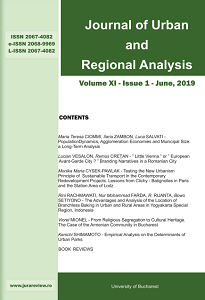TESTING THE NEW URBANISM PRINCIPLE OF SUSTAINABLE TRANSPORT IN THE CONTEMPORARY REDEVELOPMENT PROJECTS. LESSONS FROM CLICHY-BATIGNOLLES IN PARIS AND THE STATION AREA IN LODZ
TESTING THE NEW URBANISM PRINCIPLE OF SUSTAINABLE TRANSPORT IN THE CONTEMPORARY REDEVELOPMENT PROJECTS. LESSONS FROM CLICHY-BATIGNOLLES IN PARIS AND THE STATION AREA IN LODZ
Author(s): Monika Maria Cysek-PawlakSubject(s): Rural and urban sociology, Transport / Logistics
Published by: Editura Universitară
Keywords: new urbanism; sustainability; Clichy Batignolles; Lodz;
Summary/Abstract: As accessibility becomes a basic need of modern society, the issue of sustainable transportation continues to gain importance. On the large scale, it concerns interconnecting cities and metropolises, and, on a smaller scale, it refers to connection networks for pedestrians, cyclists and other means of public transport. The study aims to assess the importance of sustainable transport as a principle of New Urbanism in contemporary redevelopment projects. It introduces possible ways of implementing these principles, as well as dangers coming from misunderstanding them. The approaches and methods used in this article combine field studies conducted during the research trips, desk research and interviews with professionals at various stages of two urban renewal projects – Clichy Batignolles (France) and the main train station area in Lodz (Poland). The study revealed the strategic role of rail line redevelopment projects in both rebuilding the continuity of the urban fabric (Clichy Batignolles) and in creating a new centrality for an area with attractive cultural activities and services (Lodz). As urban project timeframes are often long, both case studies show that high flexibility and the ability to adapt investments to changing conditions are often required. Nevertheless, the realization of the key infrastructure elements should be maintained all along. Furthermore, functional diversity can provide an important support for the sustainability of the project as it ensures the quality of urban tissue through height level representative public projects, thereby giving the area in question a new image. As exemplified by the housing policy in France, the distribution of functions can also serve as a pertinent response to the strategic needs of the entire agglomeration as well as a useful solution to local problems. One of the most crucial elements of redevelopment projects is the implementation of sustainable transportation that provides quick and comfortable connections by various means of public transport within different urban scales: metropolises, cities, districts and the city. As an element of sustainable urban policy, an effective public transportation network in the inner city should be supported by the limitation of car park ratio for non-residents within the redevelopment project. Altogether, the impact that other New Urbanism principles exert on developing urban structures is a pertinent question. Today, the real challenge for this movement has moved into the city, rather than on the outskirts, as in the past.
Journal: Journal of Urban and Regional Analysis
- Issue Year: 11/2019
- Issue No: 1
- Page Range: 35-52
- Page Count: 18
- Language: English

